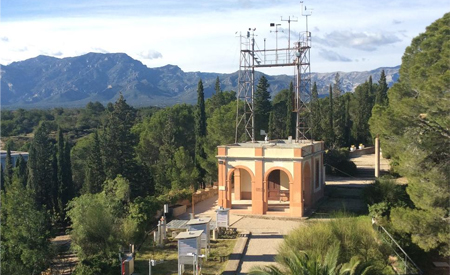The Ebro Observatory-URL University Institute takes part in a CSIC project to detect atmospheric entry of asteroid fragments and retrieve new meteorites

 David Altadill: “The study of meteorites to be retrieved may provide important clues about the origin of the planets and life on Earth”
David Altadill: “The study of meteorites to be retrieved may provide important clues about the origin of the planets and life on Earth”
Barcelona, 26 February 2015. The Spanish Higher Council for Scientific Research (Consejo Superior de Investigaciones Científicas, CSIC), the largest public research institution in Spain, manages a surveillance network from its Institute of Space Sciences (Instituto de Ciencias del Espacio, CSIC-IEEC) to detect meteorites and fireballs across the entire Iberian Peninsula.
Up until now, this network had no stations for detecting meteoric fireballs in the province of Tarragona, but this has now been resolved with the addition of equipment at the Ramon Llull University (URL) Ebro Observatory (OE).
To this end, two video detection cameras were set up six months ago, one of which is a strategic type that records all fireballs passing through the sky in Catalonia around the clock. This camera works in parallel with another of the same type located at the Montseny station, operated by the CSIC-IEEC.
The Fireballs and Meteorites Research Network (or SPMN network) studies the orbits of interplanetary rocks falling on the Iberian Peninsula and typically reaching speeds of hundreds of thousands of kph. When they enter the Earth's atmosphere, they produce bright fireballs. Sometimes the brightest meteor fireballs can deepen and generate surviving rocks, which are called meteorites when they reach the Earth's surface.
Once the trajectories in the atmosphere and the region of the sky from which these fireballs come are reconstructed, it is possible to determine their orbit and where they come from. They are usually fragments of comets and asteroids but can also be rocks that have detached from planetary bodies such as the Moon or Mars.
David Altadill, director of OE-URL: "It is fascinating to study their composition and origin. If we know where they come from, we can determine the existence of meteorite-generating swarms produced by the fragmentation of asteroids or comets close to Earth that could be potentially dangerous”.
Several extraordinary meteoric fireballs have been recorded since last August, when the OE-URL began working together with the CSIC-IEEC, up to this February. There have been three important ones:
- The first, on 21 October, was produced by a fragment of the famous comet 1P/Halley, which was visible from Catalonia.
- The second, on 24 December, was peculiar as it is categorised as an "Earth-grazing fireball" since it entered the atmosphere tangentially and then moved back out into interplanetary space with a reduced orbit as a result of this process.
- The third was registered on 10 February and can be seen in this video.
If you are interested you can track and find a list of these natural phenomena on the website of the SPMN Network.
Altadill adds that meteorites provide us with information on the raw material from which our solar system was formed and, in addition, provide fundamental clues as to the origin of terrestrial planets and the origin of life on Earth.
In fact, Altadill remarks, "they have already provided us this information and continue to do so”. “Thanks to their structure, we have been able to see that these bodies aggregate to form other smaller ones by the force of nature. Likewise, many asteroids and comets contain water and organic molecules that we can study only if we recover certain types of meteorites called carbonaceous chondrites or by missions to gather samples directly," says the director of the OE-URL.
What is the Ebro Observatory investigating along with the CSIC-URL?
More information:
Pere Quintana Seguí
Press director
Ebro Observatory - URL
Tel. 977 500 511 | pquintana@obsebre.es
You may also be interested in

Appointed by the Society of Jesus, Anna Xicoy begins her mandate with a leadership that will promote the school's founding mission and Esade-Ramon Llull University's values.




